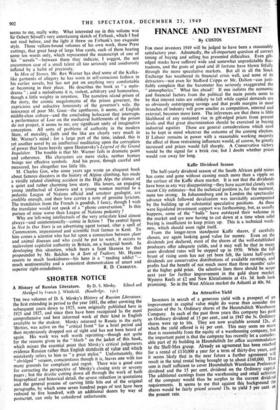FINANCE AND INVESTMENT
By CUSTOS
FOR most investors 1949 will be judged to have been a reasonably satisfactory year. Admittedly, the all-important question of correct timing of buying and selling has presented difficulties. Even gilt- edged stocks have suffered wide and somewhat unpredictable fluc- tuations, and the gusts of good and ill fortune have blown fitfully through the more speculative markets. But all in all the Stock Exchange has weathered its financial crisis well, and none of its detractors—not even Sir Stafford Cripps or Mr. Dalton—can justi- fiably complain that the barometer has seriously exaggerated the " atmospherics." What lies ahead? If one isolates the economic and financial factors from the political the main points seem to be that interest rates are unlikely to fall while capital demands are so obviously outstripping savings and that profit margins in most branches of industry will grow smaller as competition, internal and external, becomes more keen. The inferences are that there is little likelihood of any sustained rise in gilt-edged prices from present levels and that great discrimination should be exercised in buying industrial equities Those are general considerations which need to be kept in mind whatever the outcome of the coming election. If Labour remains in power with a reasonable working majority the effect of those restraining influences would, of course, be greatly increased and prices would fall sharply. A Conservative victory would be the signal for a brisk rise, but I doubt whether prices would run away for long.
Kaffir Dividend Season The half-yearly dividend season of the South African gold mines has come and gone without causing much more than a ripple on the surface of the Kaffir share market. It is not that the dividends have been in any way disappointing—they have accorded closely with recent City estimates—but the technical position is, for the moment, none too strong. In Johannesburg and in London the spectacular advance which followed devaluation was inevitably accompanied by the building up of substantial speculative positions. As these were liquidated investment support was forthcoming, but, as usually happens, some of the " bulls " have outstayed their welcome in the market and are now having to cut down at a time when solid buying is insufficient to keep prices up. This is a technical weak- ness, which should soon right itself.
From the longer-term standpoint Kaffir shares, if carefully chosen, are again looking good value for money. Even on the dividends just declared, most of the shares of the well-established producers offer adequate yields, and it may well be that in many cases dividend rates will be stepped up in 1950. While the full brunt of rising costs has not yet been felt, the latest half-yearly dividends are conservative distributions of available earnings, and profits had the benefit of not much more than three months' sales at the higher gold price. On selective lines there should be scope next year for further improvement in the gold share market. Western Reefs at £2 and New Kleinfontein at 41s. 3d. both look promising. So in the West African market do Ashanti at 40s. 9d.
An Attractive Yield
Investors in search of a generous yield with a prospect of an improvement in capital value might do worse than consider the
position of the 5s. Ordinary shares of the Houndsditch Warehouse Company. In each of the past three years this company has paid an Ordinary dividend of 15 per cent., and in 1947 the 5s. Ordinary
shares were up to 16s. They are now available around 12s., at
which the yield offered is 61- per cent. This may seem no more than is reasonable from the equity of a warehousing company, but the important point is that the company has recently let a consider- able part of its building in Houndsditch for office accommodation to the Shell-Mex. group. Already an agreement has been reached for a rental of £110,000 a year for a term of thirty-five years, and it seems likely that in the near future a further agreement will result in the total rental being brought up to about £160,000. That sum is itself sufficient to cover Houndsditch Warehouse Preference dividend and the 15 per cent. dividend on the Ordinary capital. The additional earnings from the warehousing and retail activities of the company would thus be surplus to the current dividend requirements. It seems to me that against this background the shares would be fairly priced around 15s. to yield 5 per cent. ott the present rate.


































 Previous page
Previous page